WZ-24B/48C Engineering Seismograph
WZ-24C/48C engineering seismograph is equipment from the third generation that supports the window eight systems and is multi-functioning, high-precision, and stable. Seismic source for examining is from the hammer, electric flicker, or explosion for thousand-meter depth. It applies for seismic surveys, as sheared wave velocity test, surface wave exploration, pier foundation test, ground micro-tremor determination, seismic imaging, shake measurement, refraction or reflection survey, and so on.
A seismographic network records earthquakes. Each seismic terminal in the system determines the motion of the ground in a particular area. The slip of one rock over the other in an earthquake releases energy that makes the ground vibrate. Thus the vibration pushes the adjoining piece of ground and causes it to vibrate, and thus the energy travels out from the earthquake hypocentre in a wave.
When the Earth trembles, earthquakes spread energy in the form of seismic waves. A seismograph is the primary earthquake measurement instrument. The seismograph produces a digital graphic recording of the ground motion caused by the seismic waves. The digital recording is called a seismogram.
A network of worldwide seismographs detects and measures the strength and duration of the earthquake’s waves. The seismograph produces a digital graphic plotting of the ground motion of the event.



.jpg)
.jpg)
.jpg)
